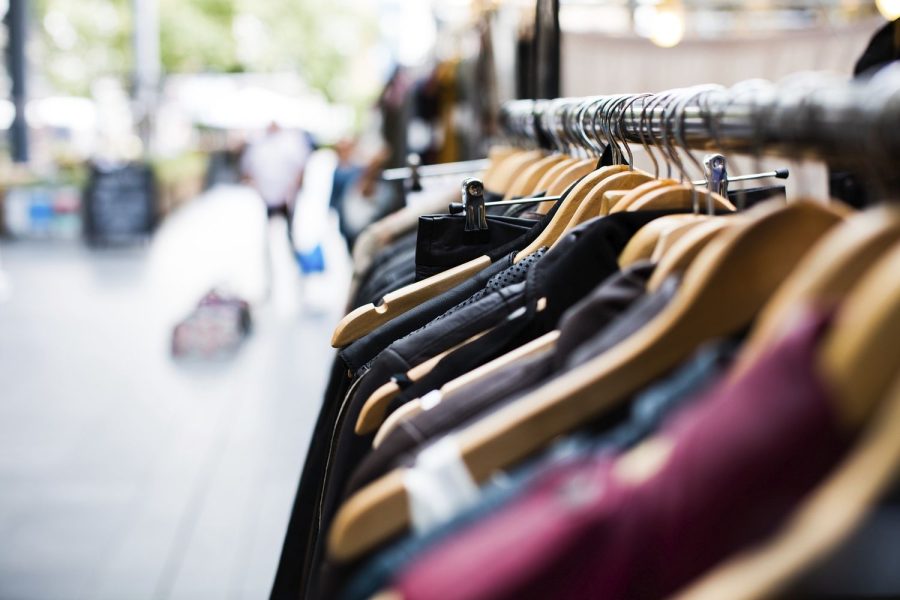The Fashion Industry and the Environment
A long row of hangers with clothes in a store in Shoreditch. Original public domain image from Wikimedia Commons
April 23, 2023
Shopping for clothes is an enjoyable and frequent pastime for many, usually done without much thought outside the usual concerns over color, fit, style, etc.. However, something unknown or ignored by most is the fashion industry’s toll on the environment, specifically the fast fashion industry. There is a lot that goes on behind the scenes in getting clothes on the shelves in stores across the world, whether online or not, and these production processes have serious repercussions for the environment.
So, what exactly is fast fashion? Fast fashion is the rapid production of clothing by mass-market retailers in response to the latest trends, which are then usually sold for low prices due to their low quality and mass production. While these clothes may be appealing to many consumers due to their low cost and trendy styles, the production of them can be incredibly harmful to the state of the environment and the buildup of pollution around the world. One of the biggest ways in which this occurs is through excessive water usage. The fast fashion industry uses an enormous amount of water in the production of clothes. In fact, the industry consumes around 79 trillion liters of water annually. A single cotton shirt takes 3,000 liters of water to produce, while one pair of jeans takes an amount of water that could fill 20,000 water bottles. Additionally, due to processes like textile dying, toxic chemicals are released into oceans which creates wastewater. Wastewater is water that has been used for domestic, industrial, or commercial purposes. Of all of the world’s wastewater, the fashion industry is responsible for producing about 20% of it. Most wastewater is too toxic to be treated to become safe again. On top of the overconsumption of water, a lot of the materials used to produce clothing are made of microplastics, which when discarded, accumulate in oceans. 35% of all microplastics are from synthetic materials used to make clothing. These plastic microfibers create toxic substances in oceans that can harm both wildlife and people when it is consumed through seafood, as this often results in negative health effects Furthermore, low quality materials, such as polyester, are often turned to by fast fashion companies in order to produce large amounts of clothing for low prices. However, these synthetic materials require 342 million barrels of oil each year to produce, and production processes on the whole require 43 million tons of chemicals per year. This incredibly high usage of nonrenewable resources causes the fashion industry to be responsible for more annual carbon emissions than all international flights and maritime shipping combined. What’s more, a 50% increase in global greenhouse gas emissions is expected if the industry does not change its ways in the coming years.
One of the main reasons the fast fashion industry specifically is so harmful is that it encourages overconsumption. Because of the low prices, high availability, and new trends, consumers often purchase more clothes than they actually wear. As of 2019, 62 million metric tons of clothing were consumed globally. On top of this, the clothing from fast fashion brands is often low quality, which leads to people throwing out clothes after only a few wears. The average American throws away 81 pounds of clothing yearly, also because most people opt to throw clothes away rather than donate them. 57% of all discarded clothing ends up in landfills, which can pose a health threat to nearby communities because of the poisonous gasses released when burning landfill.
In addition to the numerous negative impacts on the environment, the fast fashion industry poses a large human rights risk. Many fast fashion brands have moved their manufacturing to third world countries where they can utilize cheap labor while avoiding the high minimum wages of developed countries. Tremendously large numbers of employees who work as a part of the clothing production process are underpaid and work in less than ideal conditions. Many employees face long working hours and often even abuse or violence in their workplace. Furthermore, the exposure to the harmful chemicals of textile production can pose the threat of health issues. These human rights issues are something many big brands responsible for them choose to turn a blind eye to in order to continue to produce clothes at the rate that they do.
Unfortunately, some of the biggest fast fashion brands are very popular names. Shein, H&M, Forever 21, Zara, Fashion Nova, GAP, and Boohoo are some examples of large fast fashion brands. Shein is a prime example, as they add 500 products to their website daily for very low prices. In order to produce such a colossal amount of clothing, they often overlook the quality and authenticity of their clothing. The company has faced repeated backlash for copying the pieces of higher end brands. Similarly, Zara designers put out a whopping 12,000 new designs yearly. Much of the clothes bought from these companies are either quickly forgotten about or thrown away, and the production of such large amounts of clothing leads to vast amounts of pollution, both as carbon dioxide in the atmosphere and toxic substances and plastics in oceans.
Fortunately, there are ways to combat fast fashion. The best and most obvious way to do this is to avoid fast fashion brands whenever possible. While these brands may be very tempting and convenient to shop from, there are other options out there. For example, thrifting is a great and sustainable option. Thrifting allows for clothes to have a second life instead of being thrown out and a lot of pieces in thrift stores are very fairly priced, especially compared with brand new pieces. Some great thrift stores in or near Fairfield are Olive My Stuff, The Store at First Church, Back on the Rack, Carousel Thrift Shop, and Goodwill. However, if the goal is to purchase new clothes, the best thing to do is research. Before deciding what brands to support, it is important to find out a little more about how sustainable they are and what they do to offset their footprint on the environment. One thing to be wary of though is the word “sustainable” itself. Being unregulated words, any brand can call themselves sustainable or green. If a company calls themselves sustainable but also discloses very little information about their production process, chances are they are not as sustainable as they claim. The most trustworthy brands are the ones who are transparent with how and where and with what their clothes are made. Doing research on a brand before shopping from them may seem like a daunting task, but with the help of the internet, it should only take a few short minutes to get the information needed in order to determine whether a brand is worth supporting or not. There are many amazing sustainable clothing brands out there, including Outerknown, Everlane, Reformation, Patagonia, Quince, and Summersalt. These brands are transparent with how their clothes are made and they make active efforts to offset their environmental footprints. Yes, the clothes from many sustainable brands are on the expensive side. However, the intention of these brands is not for people to break the bank by buying as many pieces as they can. Instead, the goal is to focus on quality over quantity and to buy a few really well made pieces of clothes over buying countless cheaply made clothing pieces. Shopping with this mindset leads to creating a closet of high quality, long lasting, sustainably made clothes that stand the test of time and that support cleaner and less wasteful production processes.
In order to have a happy and healthy planet that can provide for generations to come, reform of the fashion industry is vital. The statistics can certainly be overwhelming, but change is possible. Raising awareness of the apparel industry’s environmental impacts is one of the first and most important steps, as this can help to create a world of more environmentally conscious consumers. As said by Nelson Mandela, “You can start changing the world for the better daily – no matter how small the action.”


